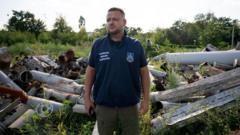The scarred landscape of Ukraine’s front lines, particularly around Kharkiv, continues to bear the deep marks of ongoing conflict. Amidst the debris and devastation left by persistent assaults, specialized investigative teams are meticulously sifting through twisted wreckage. Their work goes beyond merely documenting the destruction; these experts are gathering crucial evidence that sheds light on the nature of the attacks and, significantly, on how Russia’s war machine sustains itself despite extensive international sanctions.
Forensic analysis of destroyed military equipment and munitions often uncovers components whose origin raises questions about the effectiveness of global restrictions. Investigators frequently identify parts, including sophisticated electronics, that appear to have been manufactured in countries that have imposed strict export controls on Russia. This discovery suggests various methods of circumvention, from reliance on pre-sanction stockpiles to the use of complex supply chains involving third-party nations or shell companies. The presence of these crucial foreign-made elements in Russian weaponry indicates a persistent, albeit potentially challenging, ability for Moscow to acquire necessary materials.
Such findings on the ground underscore the complexities and inherent difficulties in completely isolating a major economy and military power through sanctions alone. While the punitive measures have undoubtedly impacted Russia’s access to certain technologies and markets, the evidence found in the field points to the ongoing struggle to fully halt the flow of critical components. The continued intensity of combat operations, reflected in the extensive wreckage, serves as a stark reminder that despite the international community’s economic pressures, Russia’s military capabilities on the front lines have not yet been definitively crippled, as it adapts and finds ways to bypass the intended restrictions.



